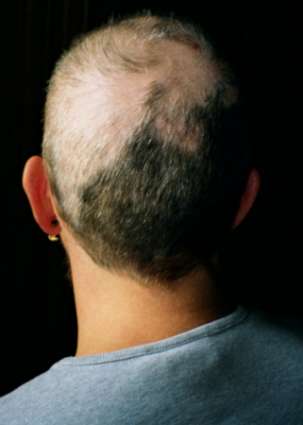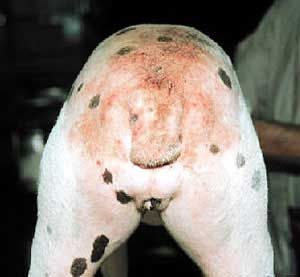
Psychogenic alopecia, also called over-grooming or psychological baldness, [1] [2] is a compulsive behavior that affects domestic cats. Generally, psychogenic alopecia does not lead to serious health consequences or a decreased lifespan. [1]

Psychogenic alopecia, also called over-grooming or psychological baldness, [1] [2] is a compulsive behavior that affects domestic cats. Generally, psychogenic alopecia does not lead to serious health consequences or a decreased lifespan. [1]
Grooming is a natural behavior for cats. Cats spend 5–25% of their waking hours grooming. [3] Grooming becomes excessive when it takes precedence over other activities or no longer seems functional. [2] [3] Excessive grooming, which can lead to hair loss, skin wounds, and ulceration, can result from chronic stress or develop in cats who already exhibit nervous temperaments. Even when the source of stress is resolved or removed, excessive grooming may continue. [2] There may be some genetic basis for the behavior, and it predominantly affects purebred cats of oriental breeds, but can develop in any feline. Female cats appear more susceptible. [2] Environmental factors suspected of causing over-grooming include flea allergy, boredom, food allergy, dust or pollen causing an allergic reaction, constipation and urinary tract infection caused by avoidance of a dirty litter tray, dermatitis, and anxiety caused by inconsistent meal times. Deprivation of sunlight could be the part of the problem for indoors only cats.
Areas affected are those the cat can access most easily, including the abdomen, legs, flank, and chest. [2]

Trichotillomania (TTM), also known as hair-pulling disorder or compulsive hair pulling, is a mental disorder characterized by a long-term urge that results in the pulling out of one's own hair. A brief positive feeling may occur as hair is removed. Efforts to stop pulling hair typically fail. Hair removal may occur anywhere; however, the head and around the eyes are most common. The hair pulling is to such a degree that it results in distress and hair loss can be seen.

Alopecia areata, also known as spot baldness, is a condition in which hair is lost from some or all areas of the body. It often results in a few bald spots on the scalp, each about the size of a coin. Psychological stress and illness are possible factors in bringing on alopecia areata in individuals at risk, but in most cases there is no obvious trigger. People are generally otherwise healthy. In a few cases, all the hair on the scalp is lost, or all body hair is lost. Hair loss can be permanent, or temporary.

Hair loss, also known as alopecia or baldness, refers to a loss of hair from part of the head or body. Typically at least the head is involved. The severity of hair loss can vary from a small area to the entire body. Inflammation or scarring is not usually present. Hair loss in some people causes psychological distress.
Skin disorders are among the most common health problems in dogs, and have many causes. The condition of a dog's skin and coat is also an important indicator of its general health. Skin disorders of dogs vary from acute, self-limiting problems to chronic or long-lasting problems requiring life-time treatment. Skin disorders may be primary or secondary in nature, making diagnosis complicated.

The health of dogs is a well studied area in veterinary medicine.
Follicular dysplasia is a genetic disease of dogs causing alopecia, also called hair loss. It is caused by hair follicles that are misfunctioning due to structural abnormality. There are several types, some affecting only certain breeds. Diagnosis is achieved through a biopsy, and treatment is rarely successful. Certain breeds, such as the Mexican Hairless Dog and Chinese Crested Dog, are bred specifically for alopecia.

A lick granuloma, also known as acral lick dermatitis, is a skin disorder found most commonly in dogs, but also in cats. In dogs, it results typically from the dog's urge to lick the lower portion of one of their legs.

Flea allergy dermatitis is an eczematous itchy skin disease of dogs and cats. For both of these domestic species, flea allergy dermatitis is the most common cause of skin disease. Affected animals develop allergic reactions to chemicals in flea saliva. Symptoms of this reaction include erythema (redness), papules (bumps), pustules, and crusts (scabs). If severe, hair loss will occur in the affected area. Dogs with flea allergy dermatitis often show hair loss and eczematous skin rash on the lower back, upper tail, neck, and down the back of the legs. Cats with flea allergy dermatitis may develop a variety of skin problems, including feline eosinophilic granuloma, miliary dermatitis, or self-inflicted alopecia from excessive grooming.
Cat skin disorders are among the most common health problems in cats. Skin disorders in cats have many causes, and many of the common skin disorders that afflict people have a counterpart in cats. The condition of a cat's skin and coat can also be an important indicator of its general health. Skin disorders of cats vary from acute, self-limiting problems to chronic or long-lasting problems requiring life-time treatment. Cat skin disorders may be grouped into categories according to the causes.

In veterinary medicine, miliary dermatitis is a multifocal distribution of skin lesions, with no identifiable pattern. The term miliary means millet-like, as the papules on the coat of an affected cat feel similar to millet seeds.

Compulsive behavior is defined as performing an action persistently and repetitively. Compulsive behaviors could be an attempt to make obsessions go away. Compulsive behaviors are a need to reduce apprehension caused by internal feelings a person wants to abstain from or control. A major cause of compulsive behavior is said to be obsessive–compulsive disorder (OCD). "The main idea of compulsive behavior is that the likely excessive activity is not connected to the purpose to which it appears directed." There are many different types of compulsive behaviors including shopping, hoarding, eating, gambling, trichotillomania and picking skin, itching, checking, counting, washing, sex, and more. Also, there are cultural examples of compulsive behavior.

First reported in 1980 by J. Tuttle in a scientific article, feline hyperesthesia syndrome, also known as rolling skin disease, is a complex and poorly understood syndrome that can affect domestic cats of any age , breed, and sex. The syndrome may also be referred to as feline hyperaesthesia syndrome, apparent neuritis, atypical neurodermatitis, psychomotor epilepsy, pruritic dermatitis of Siamese, rolling skin syndrome, and twitchy cat disease. The syndrome usually appears in cats after they've reached maturity, with most cases first arising in cats between one and five years old.

Feline acne is a problem seen in cats primarily involving the formation of blackheads accompanied by inflammation on the cat's chin and surrounding areas that can cause lesions, alopecia, and crusty sores. In many cases symptoms are mild and the disease does not require treatment. Mild cases will resemble dirt on the cat's chin, but the "dirt" will not brush off. More severe cases, however, may respond slowly to treatment and seriously detract from the health and appearance of the cat. Feline acne can affect cats of any age, sex or breed, although Persian cats are also likely to develop acne on the face and in the skin folds. This problem can happen once, be reoccurring, or even persistent throughout the cat's life.
Animal psychopathology is the study of mental or behavioral disorders in non-human animals.
Cancer in cats is the leading cause of death among cats. It is caused by uncontrolled cell growth, and affects a wide range of cell types and organs in the body. Feline cancer initially manifests as a lump or bump on any parts of the body. It rapidly grows in the affected cell, attaches itself to the tissue under the skin in that area, and, depending on the tumour, it can spread to other parts of the body. Although cancer accounts for approximately 32% of deaths in cats over ten years old, it can be successfully treated if diagnosed early.

The health of domestic cats is a well studied area in veterinary medicine.
Dogs are susceptible to allergies much like their human companions. Most allergies occur in dogs over 6 months old. A dog that is repeatedly exposed to a particular allergen becomes sensitized to it, and the immune system overreacts to a subsequent exposure, most commonly manifesting in the form of skin irritation. Some of the signs are redness, itching, hair loss, and recurring skin infections from the irritation. Skin irritation may be generalized or localized. The dog may be more prone to scratching and licking at the irritated site, further exacerbating the problem.

Alopecia in animals is a condition where locations on the body surface that are typically covered in hair, contain areas where hair is absent, and is a condition that can affect other animals besides humans. Alopecia is a condition that can affect wild organisms and captive organisms, however, the condition tends to be more prominent in captive contexts. Development of alopecia in animals is usually the sign of an underlying disease. Some animals may be genetically predisposed to hair loss, while in some it may be caused by hypersensitivity or nutritional factors. These include Moluccan cockatoos, spectacled bears, hedgehogs, raccoons, squirrels, baboons, and chimpanzees since they share 98% of human genes. Others that are selectively bred to have baldness include rabbits, guinea pigs, Syrian hamsters, mice, rats, and cats. Environmental enrichment has been used in some cases to mitigate certain behaviours that cause hair loss, improve alopecia, and address welfare concerns.

Cats exposed to allergens may develop allergies or allergic reactions. Allergies tend to become evident and intensify over extended periods of time and can take years to develop. Some allergic diseases and allergies in cats include feline atopic dermatitis, flea allergy dermatitis, feline-mosquito hypersensitivity, and food-induced allergy. In the case of feline atopy, hypersensitivity to allergens is due to genetic predisposition. However, various allergies may arise due to environmental factors. Allergens, ingested, inhaled, or airborne, can be seasonal or non-seasonal, similar to allergies in humans. Suspected seasonal allergens include but are not limited to pollen, fleas, and mosquito bites; suspected non-seasonal allergens include but are not limited to plastic materials, food, dust, trees, and grass. After exposure to suspected allergens, symptoms may be immediate or delayed, arising within a few minutes to two hours. Symptoms can include both dermatological and gastrointestinal signs such as itchy skin, hair loss and excessive scratching. In cases of feline atopic dermatitis or atopy in cats, pruritic skin diseases may result; however, signs can also include miliary dermatitis, symmetrical alopecia, and lesions of the eosinophilic granuloma complex.